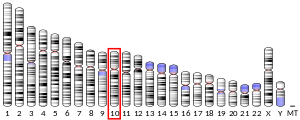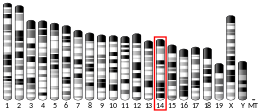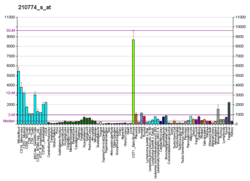NCOA4
Nuclear receptor coactivator 4 is a protein that in humans is encoded by the NCOA4 gene.[5][6][7] It plays an important role in ferritinophagy, acting as a cargo receptor, binding to the ferritin heavy chain and latching on to ATG8 on the surface of the autophagosome.
Interactions
NCOA4 has been shown to interact with:
- Androgen receptor,[6][8][9][10][11][12][13][14][15] and
- Peroxisome proliferator-activated receptor gamma[16]
- Ferritin[17][18]
- ATG8[19]
gollark: Then you're really triangular.
gollark: ...
gollark: minoteaur, which will literally never be finished, may eventually use SQLCipher to completely encrypt notes + metadata.
gollark: <:bees:724389994663247974>
gollark: Yes, a phone keyboard would not be very good for that.
See also
References
- GRCh38: Ensembl release 89: ENSG00000266412 - Ensembl, May 2017
- GRCm38: Ensembl release 89: ENSMUSG00000056234 - Ensembl, May 2017
- "Human PubMed Reference:". National Center for Biotechnology Information, U.S. National Library of Medicine.
- "Mouse PubMed Reference:". National Center for Biotechnology Information, U.S. National Library of Medicine.
- Santoro M, Dathan NA, Berlingieri MT, Bongarzone I, Paulin C, Grieco M, Pierotti MA, Vecchio G, Fusco A (February 1994). "Molecular characterization of RET/PTC3; a novel rearranged version of the RETproto-oncogene in a human thyroid papillary carcinoma". Oncogene. 9 (2): 509–16. PMID 8290261.
- Yeh S, Chang C (May 1996). "Cloning and characterization of a specific coactivator, ARA70, for the androgen receptor in human prostate cells". Proceedings of the National Academy of Sciences of the United States of America. 93 (11): 5517–21. doi:10.1073/pnas.93.11.5517. PMC 39278. PMID 8643607.
- "Entrez Gene: NCOA4 Nuclear receptor coactivator 4".
- Alen P, Claessens F, Schoenmakers E, Swinnen JV, Verhoeven G, Rombauts W, Peeters B (January 1999). "Interaction of the putative androgen receptor-specific coactivator ARA70/ELE1alpha with multiple steroid receptors and identification of an internally deleted ELE1beta isoform". Molecular Endocrinology. 13 (1): 117–28. doi:10.1210/mend.13.1.0214. PMID 9892017.
- Miyamoto H, Yeh S, Wilding G, Chang C (June 1998). "Promotion of agonist activity of antiandrogens by the androgen receptor coactivator, ARA70, in human prostate cancer DU145 cells". Proceedings of the National Academy of Sciences of the United States of America. 95 (13): 7379–84. doi:10.1073/pnas.95.13.7379. PMC 22623. PMID 9636157.
- Lin HK, Yeh S, Kang HY, Chang C (June 2001). "Akt suppresses androgen-induced apoptosis by phosphorylating and inhibiting androgen receptor". Proceedings of the National Academy of Sciences of the United States of America. 98 (13): 7200–5. doi:10.1073/pnas.121173298. PMC 34646. PMID 11404460.
- Yeh S, Lin HK, Kang HY, Thin TH, Lin MF, Chang C (May 1999). "From HER2/Neu signal cascade to androgen receptor and its coactivators: a novel pathway by induction of androgen target genes through MAP kinase in prostate cancer cells". Proceedings of the National Academy of Sciences of the United States of America. 96 (10): 5458–63. doi:10.1073/pnas.96.10.5458. PMC 21881. PMID 10318905.
- Zhou ZX, He B, Hall SH, Wilson EM, French FS (February 2002). "Domain interactions between coregulator ARA(70) and the androgen receptor (AR)". Molecular Endocrinology. 16 (2): 287–300. doi:10.1210/mend.16.2.0765. PMID 11818501.
- He B, Minges JT, Lee LW, Wilson EM (March 2002). "The FXXLF motif mediates androgen receptor-specific interactions with coregulators". The Journal of Biological Chemistry. 277 (12): 10226–35. doi:10.1074/jbc.M111975200. PMID 11779876.
- Gao T, Brantley K, Bolu E, McPhaul MJ (October 1999). "RFG (ARA70, ELE1) interacts with the human androgen receptor in a ligand-dependent fashion, but functions only weakly as a coactivator in cotransfection assays". Molecular Endocrinology. 13 (10): 1645–56. doi:10.1210/mend.13.10.0352. PMID 10517667.
- He B, Wilson EM (March 2003). "Electrostatic modulation in steroid receptor recruitment of LXXLL and FXXLF motifs". Molecular and Cellular Biology. 23 (6): 2135–50. doi:10.1128/mcb.23.6.2135-2150.2003. PMC 149467. PMID 12612084.
- Heinlein CA, Ting HJ, Yeh S, Chang C (June 1999). "Identification of ARA70 as a ligand-enhanced coactivator for the peroxisome proliferator-activated receptor gamma". The Journal of Biological Chemistry. 274 (23): 16147–52. doi:10.1074/jbc.274.23.16147. PMID 10347167.
- Mancias JD, Wang X, Gygi SP, Harper JW, Kimmelman AC (May 2014). "Quantitative proteomics identifies NCOA4 as the cargo receptor mediating ferritinophagy" (PDF). Nature. 509 (7498): 105–9. doi:10.1038/nature13148. PMC 4180099. PMID 24695223.
- Dowdle WE, Nyfeler B, Nagel J, Elling RA, Liu S, Triantafellow E, et al. (November 2014). "Selective VPS34 inhibitor blocks autophagy and uncovers a role for NCOA4 in ferritin degradation and iron homeostasis in vivo". Nature Cell Biology. 16 (11): 1069–79. doi:10.1038/ncb3053. PMID 25327288.
- Bellelli R, Federico G, Matte' A, Colecchia D, Iolascon A, Chiariello M, Santoro M, De Franceschi L, Carlomagno F (January 2016). "NCOA4 Deficiency Impairs Systemic Iron Homeostasis". Cell Reports. 14 (3): 411–421. doi:10.1016/j.celrep.2015.12.065. PMID 26776506.
Further reading
- Minoletti F, Butti MG, Coronelli S, Miozzo M, Sozzi G, Pilotti S, Tunnacliffe A, Pierotti MA, Bongarzone I (September 1994). "The two genes generating RET/PTC3 are localized in chromosomal band 10q11.2". Genes, Chromosomes & Cancer. 11 (1): 51–7. doi:10.1002/gcc.2870110108. PMID 7529046.
- Jhiang SM, Smanik PA, Mazzaferri EL (April 1994). "Development of a single-step duplex RT-PCR detecting different forms of ret activation, and identification of the third form of in vivo ret activation in human papillary thyroid carcinoma". Cancer Letters. 78 (1–3): 69–76. doi:10.1016/0304-3835(94)90033-7. PMID 8180971.
- Bongarzone I, Butti MG, Coronelli S, Borrello MG, Santoro M, Mondellini P, Pilotti S, Fusco A, Della Porta G, Pierotti MA (June 1994). "Frequent activation of ret protooncogene by fusion with a new activating gene in papillary thyroid carcinomas". Cancer Research. 54 (11): 2979–85. PMID 8187085.
- Bongarzone I, Butti MG, Fugazzola L, Pacini F, Pinchera A, Vorontsova TV, Demidchik EP, Pierotti MA (June 1997). "Comparison of the breakpoint regions of ELE1 and RET genes involved in the generation of RET/PTC3 oncogene in sporadic and in radiation-associated papillary thyroid carcinomas". Genomics. 42 (2): 252–9. doi:10.1006/geno.1997.4685. PMID 9192845.
- Miyamoto H, Yeh S, Wilding G, Chang C (June 1998). "Promotion of agonist activity of antiandrogens by the androgen receptor coactivator, ARA70, in human prostate cancer DU145 cells". Proceedings of the National Academy of Sciences of the United States of America. 95 (13): 7379–84. doi:10.1073/pnas.95.13.7379. PMC 22623. PMID 9636157.
- Alen P, Claessens F, Schoenmakers E, Swinnen JV, Verhoeven G, Rombauts W, Peeters B (January 1999). "Interaction of the putative androgen receptor-specific coactivator ARA70/ELE1alpha with multiple steroid receptors and identification of an internally deleted ELE1beta isoform". Molecular Endocrinology. 13 (1): 117–28. doi:10.1210/mend.13.1.0214. PMID 9892017.
- Kang HY, Yeh S, Fujimoto N, Chang C (March 1999). "Cloning and characterization of human prostate coactivator ARA54, a novel protein that associates with the androgen receptor". The Journal of Biological Chemistry. 274 (13): 8570–6. doi:10.1074/jbc.274.13.8570. PMID 10085091.
- Yeh S, Lin HK, Kang HY, Thin TH, Lin MF, Chang C (May 1999). "From HER2/Neu signal cascade to androgen receptor and its coactivators: a novel pathway by induction of androgen target genes through MAP kinase in prostate cancer cells". Proceedings of the National Academy of Sciences of the United States of America. 96 (10): 5458–63. doi:10.1073/pnas.96.10.5458. PMC 21881. PMID 10318905.
- Heinlein CA, Ting HJ, Yeh S, Chang C (June 1999). "Identification of ARA70 as a ligand-enhanced coactivator for the peroxisome proliferator-activated receptor gamma". The Journal of Biological Chemistry. 274 (23): 16147–52. doi:10.1074/jbc.274.23.16147. PMID 10347167.
- Gao T, Brantley K, Bolu E, McPhaul MJ (October 1999). "RFG (ARA70, ELE1) interacts with the human androgen receptor in a ligand-dependent fashion, but functions only weakly as a coactivator in cotransfection assays". Molecular Endocrinology. 13 (10): 1645–56. doi:10.1210/mend.13.10.0352. PMID 10517667.
- Hartley JL, Temple GF, Brasch MA (November 2000). "DNA cloning using in vitro site-specific recombination". Genome Research. 10 (11): 1788–95. doi:10.1101/gr.143000. PMC 310948. PMID 11076863.
- Simpson JC, Wellenreuther R, Poustka A, Pepperkok R, Wiemann S (September 2000). "Systematic subcellular localization of novel proteins identified by large-scale cDNA sequencing". EMBO Reports. 1 (3): 287–92. doi:10.1093/embo-reports/kvd058. PMC 1083732. PMID 11256614.
- Lin HK, Yeh S, Kang HY, Chang C (June 2001). "Akt suppresses androgen-induced apoptosis by phosphorylating and inhibiting androgen receptor". Proceedings of the National Academy of Sciences of the United States of America. 98 (13): 7200–5. doi:10.1073/pnas.121173298. PMC 34646. PMID 11404460.
- Basolo F, Giannini R, Monaco C, Melillo RM, Carlomagno F, Pancrazi M, Salvatore G, Chiappetta G, Pacini F, Elisei R, Miccoli P, Pinchera A, Fusco A, Santoro M (January 2002). "Potent mitogenicity of the RET/PTC3 oncogene correlates with its prevalence in tall-cell variant of papillary thyroid carcinoma". The American Journal of Pathology. 160 (1): 247–54. doi:10.1016/S0002-9440(10)64368-4. PMC 1867131. PMID 11786418.
- Zhou ZX, He B, Hall SH, Wilson EM, French FS (February 2002). "Domain interactions between coregulator ARA(70) and the androgen receptor (AR)". Molecular Endocrinology. 16 (2): 287–300. doi:10.1210/mend.16.2.0765. PMID 11818501.
- Thin TH, Kim E, Yeh S, Sampson ER, Chen YT, Collins LL, Basavappa R, Chang C (September 2002). "Mutations in the helix 3 region of the androgen receptor abrogate ARA70 promotion of 17beta-estradiol-induced androgen receptor transactivation". The Journal of Biological Chemistry. 277 (39): 36499–508. doi:10.1074/jbc.M202824200. PMID 12068007.
External links
This article incorporates text from the United States National Library of Medicine, which is in the public domain.
This article is issued from Wikipedia. The text is licensed under Creative Commons - Attribution - Sharealike. Additional terms may apply for the media files.




